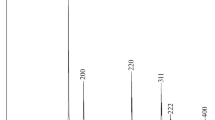Abstract
Mixing calorimetry has been used to measure the enthalpies of dysprosium germanides at 298.15-2217 K. Values have been derived for the melting points and for the enthalpies and entropies of melting. The temperature dependence of the thermodynamic functions of these compounds has been determined over a wide temperature range.
Similar content being viewed by others
References
G. V. Samsonov and V. N. Bondarev, The Germanides [in Russian], Metallurgiya, Moscow (1968).
S. M. Savitskii and V. M. Terekhova, Rare-Earth Metal Metallography [in Russian], Nauka, Moscow (1975).
Yu. I. Buyanov, T. Ya. Velikanova, and P. S. Martsenyuk, et al., Phase Equilibria and Thermodynamics of Formation for Phases in Binary Systems Formed by Rare-Earth Metals with Germanium [in Russian], Preprint, Institute for Problems of Materials Science, National Academy of Sciences of Ukraine, Kiev (1998).
V. N. Safonov, P. V. Gel'd, S. M. Barmin, et al., “Thermodynamic characteristics of some REM germanides having composition R5Ge3,” in: Abstracts for the 5th All-Union Conference on the Thermodynamics of Metal Alloys (19–21 March 1985) [in Russian], Chermetinformatsiya, Moscow (1985), p. 12.
A. S. Bolgar, N. P. Gorbachuk, and A. V. Blinder, “Enthalpies of the silicides Gd5Si3, Gd5Si4, GdSi, GdSi1.88, at 298.15–2200 K. Enthalpies of melting,” Teplofiz. Vys. Temperatur, 34, No. 4, 541–545 (1996).
E. A. Guseva, A. S. Bolgar, S. P. Gordienko, et al., “Determining the enthalpy of self-sintered silicon carbide,” Teplofiz. Vys. Temperatur, 4, No. 5, 649–653 (1966).
V. N. Eremenko, V. G. Batalin, Yu. I. Buyanov, and I. M. Obushenko, “The dysprosium — germanium phase diagram,” Dop. AN Ukr. RSR, Ser. B, No. 6, 516–521 (1977).
V. F. Litvinenko, A. S. Bolgar, V. B. Muratov, et al., Processing Measurements on Enthalpy Subject to Additional Conditions [in Russian], Institute for Problems of Materials Science, Academy of Sciences of theUkrainian SSR, Kiev (1984), deposited at VINITI 19.09.84, No. 6300B.
Project 1.6.2.8–95: High-Temperature Chemistry and Chemical Thermodynamics of Refractory Compounds and Materials Based on Them: Thermodynamic Simulation of the Synthesis of Complicated Composite Materials for Various Purposes: A Report on Research [in Ukrainian], Institute for Problems of Materials Science, National Academy of Sciences of Ukraine, Kiev (1998), No. 0299U000512.
Z. Brandt, Statistical Methods of Data Analysis [Russian translation], Mir, Moscow (1975)
E. S. R. Gopal, Specific Heats at Low Temperatures, Heywood Books, London (1966).
N. P. Gorbachuk, A. S. Bolgar, A. V. Blinder, and O. V. Boetskaya, “The enthalpies of lanthanum germanides at 300–2012 K,” Poroshk. Metall., Nos. 5–6, 70–74 (1998).
V. N. Eremenko (ed.), The Physical Chemistry of Inorganic Materials, in 3 volumes, Vol. 1 [in Russian], Nauk. Dumka, Kiev (1988).
Author information
Authors and Affiliations
Rights and permissions
About this article
Cite this article
Bolgar, A.S. Enthalpy Research and Thermodynamic Function Calculation for Dy5Ge3, DyGe, and DyGe2 at 298.15-2217 K. Powder Metallurgy and Metal Ceramics 40, 262–265 (2001). https://doi.org/10.1023/A:1012853532248
Issue Date:
DOI: https://doi.org/10.1023/A:1012853532248



